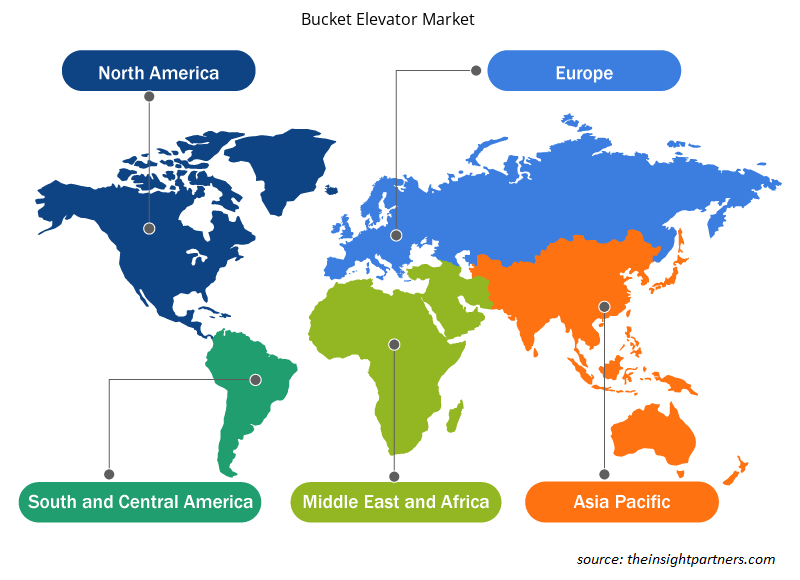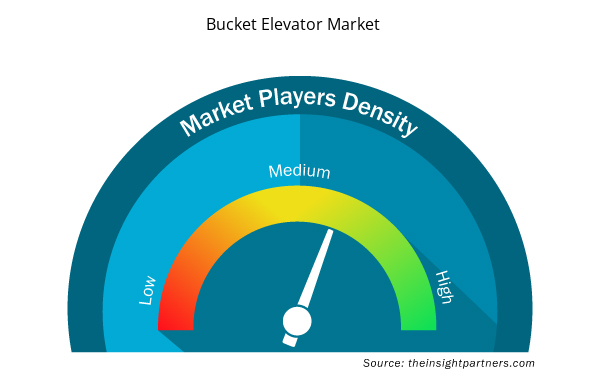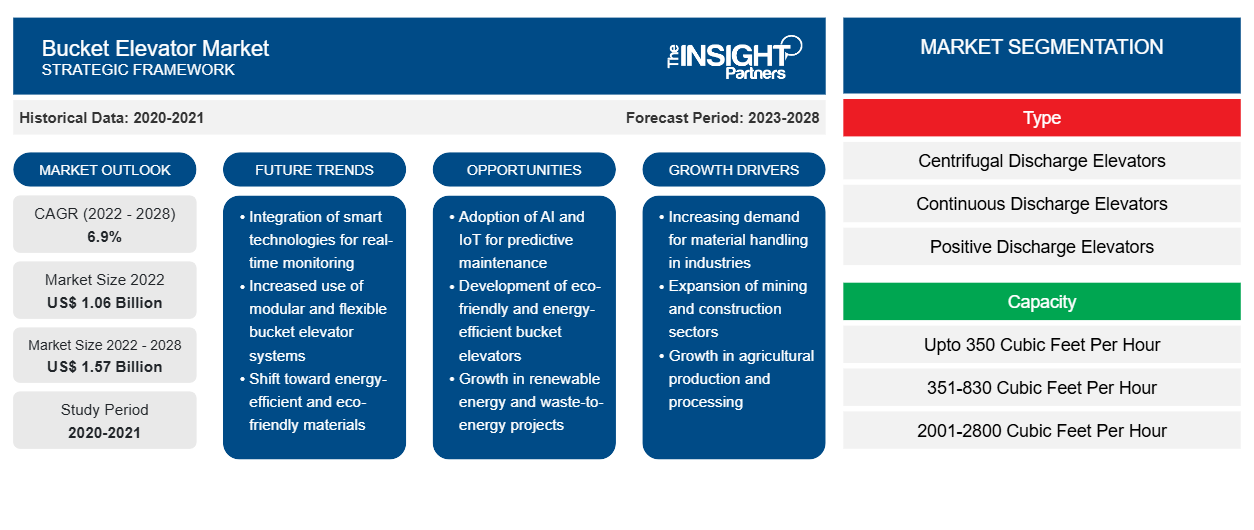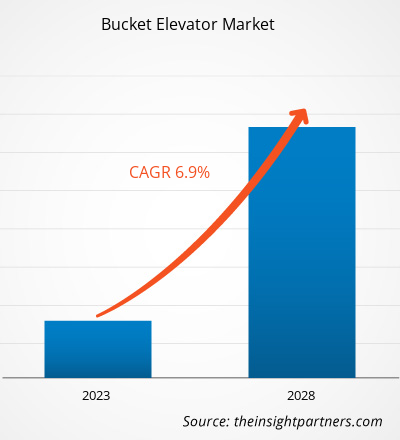Der Markt für Becherwerke soll von 1.055,12 Millionen US-Dollar im Jahr 2022 auf 1.571,40 Millionen US-Dollar im Jahr 2028 anwachsen; für den Zeitraum 2022–2028 wird mit einer durchschnittlichen jährlichen Wachstumsrate von 6,9 % gerechnet.
Becherwerke sind energie- und platzsparende Geräte zum Transport von Produkten in großen und kleinen Mengen. Sie sind in verschiedenen Typen, Ausführungen und Stilen für unterschiedliche Anwendungen erhältlich. Becherwerke werden hauptsächlich verwendet, um Material vom Boden an Orte in der Höhe zu befördern. Sie sind mit einem Baumwoll- oder Gummiriemen ausgestattet, der auf einer Antriebsscheibe an der Oberseite läuft, während das andere Ende die angetriebene Scheibe ist, die sich unten in einem gefertigten Gehäuse befindet. Kreiselbecherwerke sind der am häufigsten verwendete Aufzugstyp und werden in vielen Industrien zum vertikalen Transport von pulverförmigen Schüttgütern wie Getreide, Zucker, Sand und Mineralien verwendet. Sie werden häufig in der Zement-, Glas-, Bergbau-, Stromerzeugungs-, Biomasse-, Papier- und Bauindustrie sowie in großen Ölmühlen und anderen verarbeitenden Industrien eingesetzt.
Passen Sie diesen Bericht Ihren Anforderungen an
Sie erhalten kostenlos individuelle Anpassungen an jedem Bericht, einschließlich Teilen dieses Berichts oder einer Analyse auf Länderebene, eines Excel-Datenpakets sowie tolle Angebote und Rabatte für Start-ups und Universitäten.
- Holen Sie sich die wichtigsten Markttrends aus diesem Bericht.Dieses KOSTENLOSE Beispiel umfasst eine Datenanalyse von Markttrends bis hin zu Schätzungen und Prognosen.
Auswirkungen der COVID-19-Pandemie auf das Wachstum des Becherwerkmarktes
Die COVID-19-Pandemie hatte auf ihrem Höhepunkt im Jahr 2020 dramatische Auswirkungen auf die Weltwirtschaft. Die Krise behinderte die Geschäftstätigkeit in verschiedenen Branchen. Der Ausbruch störte mehrere Branchen, wie etwa Bauwesen, Lebensmittel, Getränke, Chemie und Bergbau. Da in den meisten Ländern Ausgangssperren herrschten, wurden Bauprojekte vorübergehend gestoppt, was die Bauunternehmer dazu zwang, ihre Arbeitsweise über Nacht umzustellen. Der Ausbruch verursachte erhebliche Störungen im Bausektor. Ein starker Rückgang des internationalen Handels wirkte sich negativ auf das Wachstum der Weltwirtschaft aus. Fabrik- und Produktionsschließungen, Handelsverbote, unterbrochene Lieferketten und Beschaffungsmanagementaktivitäten, Arbeitskräftemangel und grenzüberschreitende Bewegungsbeschränkungen zur Bekämpfung der Ausbreitung der Krankheit wirkten sich negativ auf die Arbeit von Unternehmen weltweit aus. Die negativen Auswirkungen der Pandemie auf mehrere Branchen begrenzten das Wachstum des Becherwerkmarktes . Mit der Lockerung der Beschränkungen und der Wiedereröffnung der Fabriken im Jahr 2021 haben die Branchen jedoch ein deutliches Wachstum verzeichnet. Sie konzentrieren sich nun zunehmend darauf, Bandbreite, Kompatibilität und Effizienz durch Technologieeinführung und Investitionen zu verbessern. Obwohl der globale Markt für Becherwerke im Jahr 2020 durch die COVID-19-Pandemie negativ beeinflusst wurde, hat er sich stark erholt.
Markteinblicke – Becherwerksmarkt
Der Anstieg der Bauarbeiten im Wohn-, Gewerbe- und anderen Sektoren hat das Wachstum der Zementindustrie angekurbelt. Regierungsstellen legen zunehmend Wert auf die Unterstützung von Bau- und Infrastrukturentwicklungen. Zementhersteller gehören zu den größten Kunden von Marktteilnehmern für Becherwerke. Sie haben ihre Anlagen aufgerüstet, um der steigenden Nachfrage nach Zement gerecht zu werden, die den Einbau von Becherwerken angekurbelt hat. Im Oktober 2022 wurde MDG America ausgewählt, um das Werk von Drake Cement in Paulden, Arizona, USA, mit vier hochwertigen Kettenbecherwerken zu beliefern. Im März 2021 beauftragte UltraTech Cement Limited AUMUND India mit der Lieferung eines umfassenden Ausrüstungspakets, das 46 Bandbecherwerke umfasste. Der Vertrag umfasste die Lieferung von Becherwerken für die kritische Ofenbeschickung mit Höhen von bis zu 157 m, Becherwerken für die Handhabung von Rohmaterial, Becherwerken für die Handhabung von Klinker und Zement ( verschiedene Größen) und Becherwerken mit Rollenpressen-Umlauf und Kapazitäten von bis zu 2.200 Tonnen pro Stunde (tph). Daher fördert die zunehmende Verwendung von Becherwerken in der Zementindustrie das Wachstum des Becherwerkmarktes.
Typbasierte Erkenntnisse
Der gewählte Becherwerkstyp hängt von der Anwendung ab, für die es bestimmt ist. Es wird auch ausgewählt, um den effizientesten Prozessablauf zu unterstützen. Der Becherwerksmarkt ist nach Typ in Fliehkraft-, kontinuierliche und positive Entladungsaufzüge unterteilt. Das Segment der Fliehkraft-Aufzüge hatte im Jahr 2021 den größten Marktanteil. Es wird auch erwartet, dass es im Prognosezeitraum die schnellste CAGR verzeichnet.
Der Markt für Becherwerke ist nach Typ, Kapazität, Branche und Geografie segmentiert. Nach Typ ist der Markt in Kreisel-, Dauer- und Positiv-Entladungs-Becher unterteilt. Nach Kapazität ist der Markt für Becherwerke in 350–830 Kubikfuß pro Stunde, 2001–2800 Kubikfuß pro Stunde, 831–2000 Kubikfuß pro Stunde, über 2801 Kubikfuß pro Stunde und unter 350 Kubikfuß pro Stunde unterteilt. Nach Branchen ist der Markt in Bauwesen, Landwirtschaft, Bergbau, Lebensmittel, Energie und Versorgung, Papier und Zellstoff und andere segmentiert. Geografisch ist der Markt für Becherwerke in fünf Hauptregionen segmentiert: Nordamerika, Europa, Asien-Pazifik (APAC), Naher Osten und Afrika (MEA) und Südamerika (SAM). Zu den wichtigsten Akteuren auf dem Markt für Becherwerke gehören BEUMER Group GmbH & Co KG, FEECO International Inc, Gough & Co (Engineering) Ltd, KWS Manufacturing Co Ltd, Motridal SpA, Skandia Elevator AB, Sukup Manufacturing Co, Satake Corp, Ryson International Inc und AGCO Corp.
Regionale Einblicke in den Markt für Becherwerke
Die regionalen Trends und Faktoren, die den Markt für Becherwerke im Prognosezeitraum beeinflussen, wurden von den Analysten von Insight Partners ausführlich erläutert. In diesem Abschnitt werden auch die Marktsegmente und die Geografie des Marktes für Becherwerke in Nordamerika, Europa, im asiatisch-pazifischen Raum, im Nahen Osten und Afrika sowie in Süd- und Mittelamerika erörtert.

- Holen Sie sich die regionalspezifischen Daten für den Becherwerkmarkt
Umfang des Marktberichts über Becherwerke
| Berichtsattribut | Details |
|---|---|
| Marktgröße im Jahr 2022 | 1,06 Milliarden US-Dollar |
| Marktgröße bis 2028 | 1,57 Milliarden US-Dollar |
| Globale CAGR (2022 - 2028) | 6,9 % |
| Historische Daten | 2020-2021 |
| Prognosezeitraum | 2023–2028 |
| Abgedeckte Segmente | Nach Typ
|
| Abgedeckte Regionen und Länder | Nordamerika
|
| Marktführer und wichtige Unternehmensprofile |
|
Marktteilnehmerdichte: Der Einfluss auf die Geschäftsdynamik
Der Markt für Becherwerke wächst rasant, angetrieben durch die steigende Nachfrage der Endnutzer aufgrund von Faktoren wie sich entwickelnden Verbraucherpräferenzen, technologischen Fortschritten und einem größeren Bewusstsein für die Vorteile des Produkts. Mit steigender Nachfrage erweitern Unternehmen ihr Angebot, entwickeln Innovationen, um die Bedürfnisse der Verbraucher zu erfüllen, und nutzen neue Trends, was das Marktwachstum weiter ankurbelt.
Die Marktteilnehmerdichte bezieht sich auf die Verteilung der Firmen oder Unternehmen, die in einem bestimmten Markt oder einer bestimmten Branche tätig sind. Sie gibt an, wie viele Wettbewerber (Marktteilnehmer) in einem bestimmten Marktraum im Verhältnis zu seiner Größe oder seinem gesamten Marktwert präsent sind.
Die wichtigsten auf dem Becherwerksmarkt tätigen Unternehmen sind:
- BEUMER Group GmbH & Co KG
- FEECO International Inc
- Gough & Co (Engineering) Ltd
- KWS Manufacturing Co Ltd
- Motridal SpA
Haftungsausschluss : Die oben aufgeführten Unternehmen sind nicht in einer bestimmten Reihenfolge aufgeführt.

- Überblick über die wichtigsten Akteure auf dem Becherwerksmarkt
Die Akteure auf dem Becherwerksmarkt konzentrieren sich hauptsächlich auf Produkteinführungen und Partnerschaften, um Mehrwert für den Kunden zu schaffen.
- Im Dezember 2022 brachte Ryson International, Inc. eine neue Reihe von Schüttgutaufzügen auf den Markt, die für den Transport einer Vielzahl von Schüttgütern konzipiert sind. Die neuen Schüttgutaufzüge von Ryson kombinieren vertikalen und horizontalen Transport. Die geschlossenen Aufzüge verfügen über überlappende Schwenkbehälter, um das Verschütten von Produkten zu verhindern und Fremdkörper zu vermeiden.
- Im September 2022 gaben Muller Beltex BV, VAV Aandrijvingen BV und Bechtel GmbH eine strategische Allianz bekannt, um sich besser auf dem Markt zu positionieren und ihre Kunden besser und effizienter mit Materialien, Wissen und Service zu versorgen.
- Historische Analyse (2 Jahre), Basisjahr, Prognose (7 Jahre) mit CAGR
- PEST- und SWOT-Analyse
- Marktgröße Wert/Volumen – Global, Regional, Land
- Branche und Wettbewerbsumfeld
- Excel-Datensatz


- Industrial Inkjet Printers Market
- Excimer & Femtosecond Ophthalmic Lasers Market
- Employment Screening Services Market
- Airport Runway FOD Detection Systems Market
- Gas Engine Market
- Intraoperative Neuromonitoring Market
- Batter and Breader Premixes Market
- Explosion-Proof Equipment Market
- Neurovascular Devices Market
- Clear Aligners Market

Report Coverage
Revenue forecast, Company Analysis, Industry landscape, Growth factors, and Trends

Segment Covered
This text is related
to segments covered.

Regional Scope
North America, Europe, Asia Pacific, Middle East & Africa, South & Central America

Country Scope
This text is related
to country scope.
Häufig gestellte Fragen
BEUMER Group GmbH & Co KG, FEECO International Inc, Gough & Co (Engineering) Ltd, KWS Manufacturing Co Ltd, Motridal SpA, Skandia Elevator AB, Sukup Manufacturing Co, Satake Corp, Ryson International Inc, and AGCO Corp are the leading companies in the bucket elevators market.
Integration of predictive maintenance solutions is one of the major trends in the bucket elevators market.
North America dominated the bucket elevators market in 2021. In the past decade, logistics in North America have seen tremendous growth, owing to factors such favorable measures by governments, and investments by public and private authorities promote the growth of different industries in the region. Cement manufacturers, fertilizer manufacturers, grain processing plants, and mining sites are a few of the major end users of bucket elevators in North American countries. A rise in construction activities across these countries is a key contributor to the demand for bucket elevators, as these systems are used in the vertical transportation of sand, cement, and bricks in the construction industry.
Growth in infrastructure projects promoting application of bucket elevators in cement plants augments the growth of the bucket elevators market.
Growing demand of food grains and seeds is creating growth opportunity for the market players operating into the market.
Trends and growth analysis reports related to Electronics and Semiconductor : READ MORE..
The List of Companies - Bucket Elevator Market
- BEUMER Group GmbH & Co KG
- FEECO International Inc
- Gough & Co (Engineering) Ltd
- KWS Manufacturing Co Ltd
- Motridal SpA
- Skandia Elevator AB
- Sukup Manufacturing Co
- Satake Corp
- Ryson International Inc
- AGCO Corp
The Insight Partners performs research in 4 major stages: Data Collection & Secondary Research, Primary Research, Data Analysis and Data Triangulation & Final Review.
- Data Collection and Secondary Research:
As a market research and consulting firm operating from a decade, we have published and advised several client across the globe. First step for any study will start with an assessment of currently available data and insights from existing reports. Further, historical and current market information is collected from Investor Presentations, Annual Reports, SEC Filings, etc., and other information related to company’s performance and market positioning are gathered from Paid Databases (Factiva, Hoovers, and Reuters) and various other publications available in public domain.
Several associations trade associates, technical forums, institutes, societies and organization are accessed to gain technical as well as market related insights through their publications such as research papers, blogs and press releases related to the studies are referred to get cues about the market. Further, white papers, journals, magazines, and other news articles published in last 3 years are scrutinized and analyzed to understand the current market trends.
- Primary Research:
The primarily interview analysis comprise of data obtained from industry participants interview and answers to survey questions gathered by in-house primary team.
For primary research, interviews are conducted with industry experts/CEOs/Marketing Managers/VPs/Subject Matter Experts from both demand and supply side to get a 360-degree view of the market. The primary team conducts several interviews based on the complexity of the markets to understand the various market trends and dynamics which makes research more credible and precise.
A typical research interview fulfils the following functions:
- Provides first-hand information on the market size, market trends, growth trends, competitive landscape, and outlook
- Validates and strengthens in-house secondary research findings
- Develops the analysis team’s expertise and market understanding
Primary research involves email interactions and telephone interviews for each market, category, segment, and sub-segment across geographies. The participants who typically take part in such a process include, but are not limited to:
- Industry participants: VPs, business development managers, market intelligence managers and national sales managers
- Outside experts: Valuation experts, research analysts and key opinion leaders specializing in the electronics and semiconductor industry.
Below is the breakup of our primary respondents by company, designation, and region:

Once we receive the confirmation from primary research sources or primary respondents, we finalize the base year market estimation and forecast the data as per the macroeconomic and microeconomic factors assessed during data collection.
- Data Analysis:
Once data is validated through both secondary as well as primary respondents, we finalize the market estimations by hypothesis formulation and factor analysis at regional and country level.
- Macro-Economic Factor Analysis:
We analyse macroeconomic indicators such the gross domestic product (GDP), increase in the demand for goods and services across industries, technological advancement, regional economic growth, governmental policies, the influence of COVID-19, PEST analysis, and other aspects. This analysis aids in setting benchmarks for various nations/regions and approximating market splits. Additionally, the general trend of the aforementioned components aid in determining the market's development possibilities.
- Country Level Data:
Various factors that are especially aligned to the country are taken into account to determine the market size for a certain area and country, including the presence of vendors, such as headquarters and offices, the country's GDP, demand patterns, and industry growth. To comprehend the market dynamics for the nation, a number of growth variables, inhibitors, application areas, and current market trends are researched. The aforementioned elements aid in determining the country's overall market's growth potential.
- Company Profile:
The “Table of Contents” is formulated by listing and analyzing more than 25 - 30 companies operating in the market ecosystem across geographies. However, we profile only 10 companies as a standard practice in our syndicate reports. These 10 companies comprise leading, emerging, and regional players. Nonetheless, our analysis is not restricted to the 10 listed companies, we also analyze other companies present in the market to develop a holistic view and understand the prevailing trends. The “Company Profiles” section in the report covers key facts, business description, products & services, financial information, SWOT analysis, and key developments. The financial information presented is extracted from the annual reports and official documents of the publicly listed companies. Upon collecting the information for the sections of respective companies, we verify them via various primary sources and then compile the data in respective company profiles. The company level information helps us in deriving the base number as well as in forecasting the market size.
- Developing Base Number:
Aggregation of sales statistics (2020-2022) and macro-economic factor, and other secondary and primary research insights are utilized to arrive at base number and related market shares for 2022. The data gaps are identified in this step and relevant market data is analyzed, collected from paid primary interviews or databases. On finalizing the base year market size, forecasts are developed on the basis of macro-economic, industry and market growth factors and company level analysis.
- Data Triangulation and Final Review:
The market findings and base year market size calculations are validated from supply as well as demand side. Demand side validations are based on macro-economic factor analysis and benchmarks for respective regions and countries. In case of supply side validations, revenues of major companies are estimated (in case not available) based on industry benchmark, approximate number of employees, product portfolio, and primary interviews revenues are gathered. Further revenue from target product/service segment is assessed to avoid overshooting of market statistics. In case of heavy deviations between supply and demand side values, all thes steps are repeated to achieve synchronization.
We follow an iterative model, wherein we share our research findings with Subject Matter Experts (SME’s) and Key Opinion Leaders (KOLs) until consensus view of the market is not formulated – this model negates any drastic deviation in the opinions of experts. Only validated and universally acceptable research findings are quoted in our reports.
We have important check points that we use to validate our research findings – which we call – data triangulation, where we validate the information, we generate from secondary sources with primary interviews and then we re-validate with our internal data bases and Subject matter experts. This comprehensive model enables us to deliver high quality, reliable data in shortest possible time.


 Holen Sie sich ein kostenloses Muster für diesen Bericht
Holen Sie sich ein kostenloses Muster für diesen Bericht